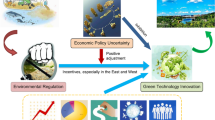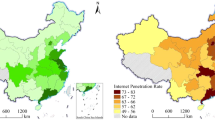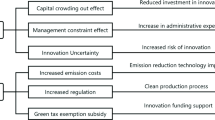Abstract
China is facing increasingly severe challenges of environmental pollution and resource depletion in pursuit of economic growth. Consequently, it is imperative to investigate the influence of environmental regulations on the enhancement of quantity and quality in urban green technological innovation, alongside the role of the digital development. By leveraging panel data of 230 cities in China from 2011 to 2021, this study systematically examines the impact of environmental regulation on the quantity and quality of green technological innovation, and the moderating effect of the digital development. Findings reveal that as the level of environmental regulation rises, not only the quantity but also the quality of urban green technological innovation increase. Furthermore, the digital development further strengthens the promotional effect of environmental regulation on the quantity of urban green innovation, yet insignificantly impacting innovation quality. It is noteworthy that the favorable environment for digital development enhances the promotional effects of environmental regulations on both the quantity and quality of urban green innovation. Simultaneously, as the level of the digital development advances, environmental regulation will ultimately significantly promote the improvement in the quality of green innovation.
Similar content being viewed by others
Data availability
The data that support the findings of this study are available from the corresponding author, [Ming Zhang], upon reasonable request.
Notes
The specific environmental-related vocabulary includes: environmental protection, energy consumption, pollution control, haze, pollution, ecology, emission reduction, discharge, green, air, low-carbon, chemical oxygen demand, carbon dioxide, sulfur dioxide, PM10, PM2.5, desulfurization, and denitrification.
References
Cao, S. P., Nie, L., Sun, H. P., et al. (2021). Digital finance, green technological innovation and energy-environmental performance: Evidence from China’s regional economies. Journal of Cleaner Production, 327, 129458.
Caputo, M. R. (2014). Comparative statics of a monopolistic firm facing price-cap and command-and-control environmental regulations. Energy Economics, 46, 464–471.
Chen, Z., Kahn, M. E., Liu, Y., et al. (2018). The consequences of spatially differentiated water pollution regulation in China. Journal of Environmental Economic Management, 88, 468–485.
Chen, X., Liu, B. Y., Ma, Y. L., et al. (2023). Building back greener: Promoting performance in natural resource markets for sustainable development. Resources Policy, 86, 104220.
Dong, X. F., Zheng, S. Q., & Kahn, M. E. (2019). The role of transportation speed in facilitating high skilled teamwork across cities. Journal of Urban Economics, 115, 103212.
Gao, X., & Li, M. (2022). Implementation of enterprises’ green technology innovation under market-based environmental regulation: An evolutionary game approach. Journal of Environment Management, 308, 114570.
Ghimire, A., Ali, S., Long, X. L., et al. (2024). Effect of digital silk road and innovation heterogeneity on digital economy growth across 29 countries: New evidence from PSM-DID. Technological Forecasting and Social Change, 198, 122987.
Jiang, L., & Bai, Y. (2022). Strategic or substantive innovation? The impact of institutional investors’ site visits on green innovation evidence from China. Technology in Society, 68, 101904.
Jiang, Z. Y., Wang, Z. J., & Li, Z. B. (2018). The effect of mandatory environmental regulation on innovation performance: Evidence from China. Journal of Cleaner Production, 203, 482–491.
Kloppenburg, S., Gupta, A., Kruk, S. R. L., et al. (2022). Scrutinizing environmental governance in a digital age: New ways of seeing, participating, and intervening. One Earth, 5(3), 232–241.
Li, Y. X., & Wang, F. S. (2023). The corporate path to green innovation: Does the digital economy matter? Environmental Science and Pollution Research, 30(32), 79149–79160.
Li, J., Chen, L., Chen, Y., et al. (2021). Digital economy, technological innovation, and green economic efficiency—empirical evidence from 277 cities in China. Managerial and Decision Economics, 43, 616–629.
Lin, B. Q., & Xie, Y. J. (2023). Positive or negative? R&D subsidies and green technology innovation: Evidence from China’s renewable energy industry. Renewable Energy, 213, 148–156.
Liu, J. L., Chen, Y. Y., & Liang, F. Y. (2023). The effects of digital economy on breakthrough innovations: Evidence from Chinese listed companies. Technological Forecasting and Social Change, 196, 122866.
Luo, S., & Sun, Y. (2020). Do selective R&D incentives from the government promote substantive innovation? Evidence from Shanghai technological enterprises. Asian Journal of Technology Innovation, 28(3), 323–342.
Luo, S. Y., Yimamu, N., Li, Y. R., et al. (2022). Digitalization and sustainable development: How could digital economy development improve green innovation in China? Business Strategy and the Environment, 32(4), 1847–1871.
Milani, S. (2017). The impact of environmental policy stringency on industrial R&D conditional on pollution intensity and relocation costs. Environmental and Resource Economics, 68(3), 595–620.
Mille, J. G. (2005). The political evolution of principal-agent models. Annual Review of Political Science, 8(1), 203–225.
Noailly, J., & Smeets, R. (2015). Directing technical change from fossil-fuel to renewable energy innovation: An application using firm-level patent data. Journal of Environmental Economics and Management, 72(3), 15–37.
Pan, M. J., Zhao, X., Lv, K. J., et al. (2023). Internet development and carbon emission-reduction in the era of digitalization: Where will resource-based cities go? Resources Policy, 81, 103345.
Porter, M. E. (1991). America’s green strategy. Scientific American, 264(4), 168.
Porter, M. E., & Van-der-Linde, C. (1995). Toward a new conception of the environment-competitiveness relationship. Journal of Economic Perspectives, 9(4), 97–118.
Ren, S., Li, L., Han, Y., et al. (2022). The emerging driving force of inclusive green growth: Does digital economy agglomeration work? Business Strategy and the Environment, 31(4), 1656–1678.
Rong, K., & Luo, Y. N. (2023). Toward born sharing: The sharing economy evolution enabled by the digital ecosystems. Technological Forecasting and Social Change, 196, 122776.
Song, Y., Zhang, L., & Zhang, M. (2024). Environmental regulatory competition and haze pollution: Beggar thy neighbor or benefit thy neighbor? Air Quality. Atmosphere & Health, 17, 283–294.
Wang, H. L., & Guo, J. G. (2024). New way out of efficiency-equity dilemma: Digital technology empowerment for local government environmental governance. Technological Forecasting and Social Change, 200, 123184.
Wang, J. L., Wang, W. L., Ran, Q. Y., et al. (2021a). Analysis of the mechanism of the impact of internet development on green economic growth: Evidence from 269 prefecture cities in China. Environmental Science and Pollution Research, 29(7), 9990–10004.
Wang, L., Chen, Y. Y., Ramsey, T. S., et al. (2021b). Will researching digital technology really empower green development? Technology in Society, 66(10), 101638.
Wang, A. L., Si, L. L., & Hu, S. (2023). Can the penalty mechanism of mandatory environmental regulations promote green innovation? Evidence from China’s enterprise data. Energy Economics, 125, 106956.
Wu, H., Hao, Y., Ren, S., et al. (2021). Does internet development improve green total factor energy efficiency? Evidence from China. Energy Policy, 153, 112247.
Wu, F. J., Wang, W., Hong, J. G., et al. (2023). Environmental decentralization and green development: The mediating role of industrial upgrading. Environmental Science and Pollution Research, 30(44), 99965–99978.
Xiong, L. X., Ning, J. J., & Dong, Y. H. (2022). Pollution reduction effect of the digital transformation of heavy metal enterprises under the agglomeration effect. Journal of Cleaner Production, 330, 129864.
Yu, F. F., Jiang, D., & Wang, T. (2022). The impact of green innovation on manufacturing small and medium enterprises corporate social responsibility fulfillment: The moderating role of regional environmental regulation. Corporate Social Responsibility and Environmental Management, 29(3), 712–727.
Zhang, M., Yan, T. H., Gao, W., et al. (2023). How does environmental regulation affect real green technology innovation and strategic green technology innovation? Science of the Total Environment, 872, 162221.
Zhou, G., Liu, W., Wang, T., et al. (2021). Be regulated before be innovative? How environmental regulation makes enterprises technological innovation do better for public health. Journal of Cleaner Production, 11, 126965.
Acknowledgements
The authors gratefully acknowledge the financial support from the National Natural Science Foundation of China (72173094, 72174195), and Innovation Capability Support Program of Shaanxi (2024ZC-YBXM-096).
Author information
Authors and Affiliations
Corresponding authors
Ethics declarations
Competing interests
The authors declared that they have no conflicts of interest to this work
Additional information
Publisher’s Note
Springer Nature remains neutral with regard to jurisdictional claims in published maps and institutional affiliations.
Rights and permissions
Springer Nature or its licensor (e.g. a society or other partner) holds exclusive rights to this article under a publishing agreement with the author(s) or other rightsholder(s); author self-archiving of the accepted manuscript version of this article is solely governed by the terms of such publishing agreement and applicable law.
About this article
Cite this article
Song, Y., Zhang, L., Dong, X. et al. Can environmental regulation foster incremental enhancement and quality improvement in green technological innovation under the background of the digital development?. Environ Dev Sustain (2024). https://doi.org/10.1007/s10668-024-04862-5
Received:
Accepted:
Published:
DOI: https://doi.org/10.1007/s10668-024-04862-5




